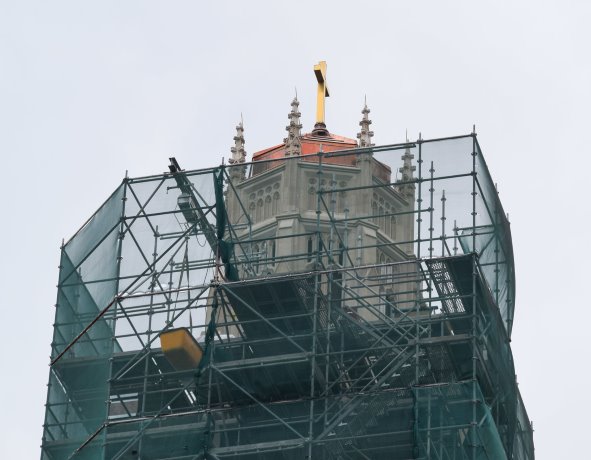You can’t miss Hamilton, Ont.’s most prominent rehab job as you drive into the city from the east on Highway 403.
The Cathedral Basilica of Christ the King, the seat of the Bishop of the Diocese of Hamilton and the cathedral of the Diocese of Hamilton, rises 50 metres tall. Since last fall it has been covered by green netting and scaffolding extending a full 21 storeys to the top.
Father David Wynen, the parish rector, and Moe Kowal, the project manager, explained in a recent onsite interview that the structure was designed in Gothic style by William Souter and constructed with a steel frame and limestone and sandstone cladding from 1931 to 1933 by Hamilton firm Pigott Construction. It was extremely well built but roofing deterioration and other factors allowed damaging moisture to seep into the structure.
As well, over the 84 years, carbon and other pollutants, including automobile exhaust from vehicles on the nearby 403, had stained the stone. Further damage was caused by a deficient lightning-rod system.
And so the parish budgeted $3.5 million for repairs to the cathedral’s copper roof, roof substrata and damaged stone and for thorough cleaning of all stone exteriors on the cathedral and the adjacent rector’s and bishop’s residences.
Wynen acknowledged the cathedral’s role as a city landmark.
"It is a treasure that the city has," he said. "I am sure once it is finished, the community will appreciate having the cathedral restored."
Both Wynen and Kowal have been involved in diocese construction jobs before and Kowal serves as a building liaison for the diocese’s 125 parishes with their numerous aging churches and other buildings. On the Hamilton job there are weekly meetings with representatives of the general contractor, Semple Gooder Roofing Corp. of Toronto, and stone rehabilitation experts Clifford Restoration, also of Toronto. IRC Building Sciences Group of Mississauga is advising the diocese as the consultant.
"I keep an eye on things to know what’s getting done," said Kowal. "We’re a good team."
Stone cleaning at the two residences began in the fall of 2016. The whole project is set for completion this November, with scaffolding to be removed in sections as work proceeds to heighten the anticipation of parishioners, said Wynen.
A dozen storeys up the bell tower scaffolding, which was installed by Tower Scaffold Services of Toronto, Clifford site foreman Joe Costello was supervising stonework. Clifford had conducted an inventory of stone damage including deterioration of detailing on pinnacles and other features and decided what had to be replaced, Costello said. A Mississauga firm, Traditional Cut Stone, is doing detailing and rock repointing.
"The limestone was the easiest to clean," said Costello. "The rock face was more tedious with all of the carbons on it, so it took more time and effort to clean, but overall it cleaned up nice."
The limestone, originally sourced from Indiana and Port Credit in Mississauga, is too soft to sandblast, Costello explained, so an alternative process is being employed.
"We rinse the building down, get it good and wet, and then we put a product on called One Restore, put it on for a couple of minutes, let it do its thing, then use a pressure washer to wash it off," said Costello.
Typically, 15 to 20 workers from Clifford have been on site at the cathedral, said Costello.
"It’s really gratifying watching the building being cleaned and taking shape," he said.
Further up, diocese caretaker Sandor Kollarich talked about work to maintain the 23-bell carillon. The largest, called the Bourdon Bell, manufactured by Steinmeyer Foundry in London, England, said Kollarich, weighs four-and-a-half tons and was donated by then Prime Minister R. B. Bennett, a friend of Bishop McNally. The diocese had Verdin Bells and Clocks of Cincinnati, Ohio in to examine the system.
"The Bourdon Bell, it was free swinging so it was compromising the structure of the building, the weight of it," said Kollarich. "So what they did, they have made it stationary as it strikes so it is not putting out all the extra vibration."
Up top, on the 17th level just below the crown of the bell tower, a crew of four from Semple Gooder was replacing old copper roofing under the supervision of site foreman Paul Da Silva.
Da Silva used a crowbar to remove damaged copper and showed how the malleable material had been supported by a single iron bar, causing sagging under heavy snow. Below was damaged stone.
"Heat comes from inside the church, so condensation starts building and eventually moisture gets in the mortar. In the winter it is a big issue, it starts going into joints and it cracks everything," he explained.
Da Silva said in that section of roofing, the iron bars are being replaced by three-quarter-inch plywood and Blueskin is being applied as a vapour barrier before new copper flashing is installed.
At the very top, there was a recent ceremony held as repairs to the cathedral’s golden cross were concluded. The cross is made of timber with copper cladding. The rector explained that some time ago the cladding, discoloured over time, had been painted gold.
The diocese decided to replace the copper cladding with a product called Nordic Royal, a combination of copper, zinc and aluminum that is similar to the blend used in the loonie. The new golden-coloured cross will dull over time but will retain a golden colour, said Wynen.

1/3
Photo:
2/3












Recent Comments
comments for this post are closed